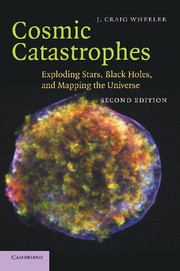Book contents
- Frontmatter
- Contents
- Preface
- 1 Setting the stage: star formation and hydrogen burning in single stars
- 2 Stellar death: the inexorable grip of gravity
- 3 Dancing with stars: binary stellar evolution
- 4 Accretion disks: flat stars
- 5 White dwarfs: quantum dots
- 6 Supernovae: stellar catastrophes
- 7 Supernova 1987A: lessons and enigmas
- 8 Neutron stars: atoms with attitude
- 9 Black holes in theory: into the abyss
- 10 Black holes in fact: exploring the reality
- 11 Gamma-ray bursts, black holes and the Universe: long, long ago and far, far away
- 12 Supernovae and the Universe
- 13 Wormholes and time machines: tunnels in space and time
- 14 Beyond: the frontiers
- Index
11 - Gamma-ray bursts, black holes and the Universe: long, long ago and far, far away
Published online by Cambridge University Press: 14 September 2009
- Frontmatter
- Contents
- Preface
- 1 Setting the stage: star formation and hydrogen burning in single stars
- 2 Stellar death: the inexorable grip of gravity
- 3 Dancing with stars: binary stellar evolution
- 4 Accretion disks: flat stars
- 5 White dwarfs: quantum dots
- 6 Supernovae: stellar catastrophes
- 7 Supernova 1987A: lessons and enigmas
- 8 Neutron stars: atoms with attitude
- 9 Black holes in theory: into the abyss
- 10 Black holes in fact: exploring the reality
- 11 Gamma-ray bursts, black holes and the Universe: long, long ago and far, far away
- 12 Supernovae and the Universe
- 13 Wormholes and time machines: tunnels in space and time
- 14 Beyond: the frontiers
- Index
Summary
GAMMA-RAY BURSTS: YET ANOTHER COSMIC MYSTERY
There was a revolution in astronomy in the first few months of 1997. A major breakthrough occurred in one of the outstanding mysteries of modern astrophysics, the cosmic gamma-ray bursts. This story began in the 1960s. The United States launched a series of satellites that orbited the Earth at great distance, halfway to the Moon. They were called the Vela series, and they were designed to detect gamma rays and other high-energy photons and particles. If it strikes you that there must be something special about them to be so far from Earth, you are on the right track. They were not designed for astronomy, but primarily to detect terrestrial nuclear-bomb tests. They were also intended to study the background, other natural sources of high-energy photons and particles in the solar wind and the Earth's magnetosphere, to aid in the separation of bomb signals from natural signals.
Stirling Colgate was on the team in Geneva in 1959 working on the treaty to ban space, atmospheric, and underwater nuclear tests. He had done some calculations that suggested that when a supernova shock wave broke through the surface of the star there could be a pulse of gamma rays (see Section 11.4 in this chapter for an update of this topic). He was afraid that such an event would be misunderstood as a nuclear bomb and might trigger a serious miscalculation by one side or the other.
- Type
- Chapter
- Information
- Cosmic CatastrophesExploding Stars, Black Holes, and Mapping the Universe, pp. 229 - 262Publisher: Cambridge University PressPrint publication year: 2007



